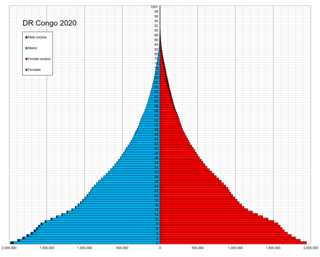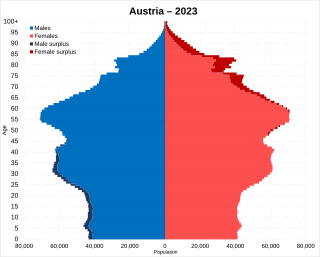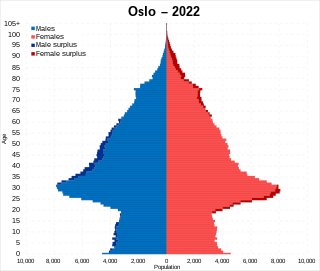
Demographic features of the population of the Democratic Republic of the Congo include ethnicity, education level, health, economic status, religious affiliations and other aspects of the population.

Demographic features of the population of Denmark include ethnicity, education level, health of the populace, economic status, religious affiliations, and other aspects.

This is a demography of the population of the Dominican Republic including population density, ethnicity, education level, health of the populace, economic status, religious affiliations and other aspects of the population.

The demographics of Finland is monitored by the Statistics Finland. Finland has a population of over 5.6 million people, ranking it 19th out of 27 within the European Union. The average population density in Finland is 19 inhabitants per square kilometre (49/sq mi), making it the third most sparsely populated country in Europe, after Iceland and Norway. Population distribution is extremely uneven, with the majority of the population concentrated in the southern and western regions of the country. The majority of the Finnish population - approximately 73% - lives in urban areas. Approximately 1.6 million, or almost 30%, reside solely in the Helsinki Metropolitan Area. Conversely, the Arctic Lapland region contains only two inhabitants per square kilometre (5.2/sq mi).

Ireland had an estimated population of 5,281,600 as of 1 April 2023.

The demography of Sweden is monitored by the Statistiska centralbyrån. Sweden's population was 10,555,448, making it the 15th-most populous country in Europe after Czech Republic, the 10th-most populous member state of the European Union, and the 87th-most populous country in the world. The total fertility rate was rated at 1.66 in 2020, which is far below the replacement rate of 2.1.

As of 1 January 2020, Spain had a total population of 47,431,256, which represents a 0.9% increase since 2019. The modern Kingdom of Spain arose from the accretion of several independent Iberian realms, including the Kingdoms of León, Castile, Navarre, the Crown of Aragon and Granada, all of which, together with the modern state of Portugal, were successor states to the late antique Christian Visigothic Kingdom after the Reconquista.

This is a demography of the population of Uruguay including population density, ethnicity, education level, health of the populace, economic status, religious affiliations and other aspects of the population.

Demographic features of the population of the Netherlands include population density, ethnicity, education level, health of the population, economic status, religious affiliations and other aspects of the population.

The demographics of Iceland include population density, education level, health of the populace, economic status, religious affiliations and other aspects of the population.

Demographic features of the population of Belgium include ethnicity, education level, health of the populace, economic status, religious affiliations and other aspects. All figures are from the National Institute for Statistics unless otherwise indicated.

The demography of France is monitored by the Institut national d'études démographiques (INED) and the Institut national de la statistique et des études économiques (INSEE). As of 1 January 2021, 65,250,000 people lived in Metropolitan France, while 2,785,000 lived in overseas France, for a total of 68,035,000 inhabitants in the French Republic.

This is a demography of Argentina including population density, ethnicity, economic status and other aspects of the population.

The population of Australia is estimated to be 27,079,800 as of 10 March 2024. Australia is the 56th most populous country in the world and the most populous Oceanian country. Its population is concentrated mainly in urban areas, particularly on the Eastern, South Eastern and Southern seaboards, and is expected to exceed 30 million by 2029.

Demographic features of the population of Austria include population density, ethnicity, education level, health of the populace, economic status, religious affiliations and other aspects of the population.

The population of Oslo is monitored by Statistics Norway. As of 2022, the population of Oslo sat at 702,543.

Immigration to Europe has a long history, but increased substantially after World War II. Western European countries, especially, saw high growth in immigration post 1945, and many European nations today have sizeable immigrant populations, both of European and non-European origin. In contemporary globalization, migrations to Europe have accelerated in speed and scale. Over the last decades, there has been an increase in negative attitudes towards immigration, and many studies have emphasized marked differences in the strength of anti-immigrant attitudes among European countries.
In 2017, Norway's immigrant population consisted of 883,751 people, making up 16.8% of the country's total population. Of this number, 724,987 are foreign-born, while 158,764 are Norwegian-born with foreign-born parents. The ten most common countries of origin of immigrants residing in Norway are Poland (97,197), Lithuania (37,638), Sweden (36,315), Somalia (28,696), Germany (24,601), Iraq (22,493), Syria (20,823), Philippines (20,537), Pakistan (19,973) and Eritrea (19,957). The immigrant population comprises people from a total of 221 countries and autonomous regions, but 25% of the immigrants are from one of four migrant groups: Polish, Lithuanians, Swedes and Somalis.
African immigration to Norway refers to immigrants to Norway from Africa. An estimated 150,000 people in Norway are either first or second generation immigrants from Africa. Most of these have a background as asylum seekers.
The Albanians in the Nordic countries refers to the Albanian migrants in Nordic countries such as Denmark, Faroe Islands, Finland, Norway and Sweden and their descendants.































